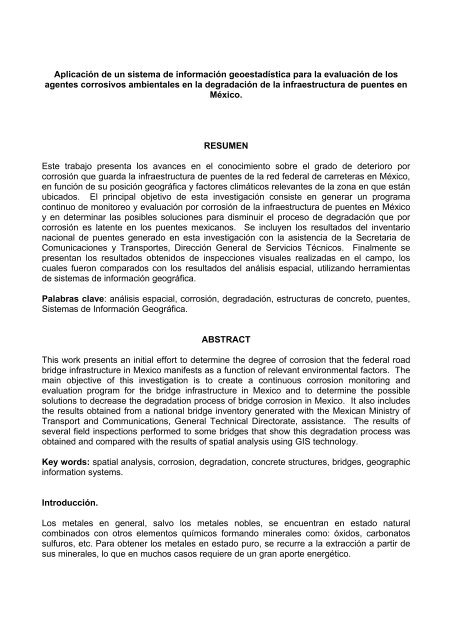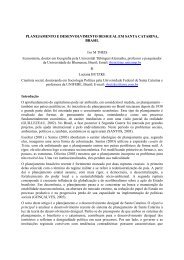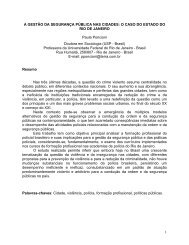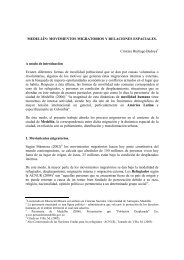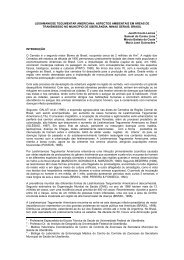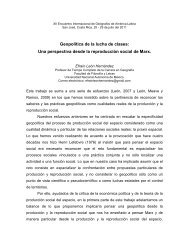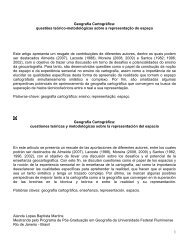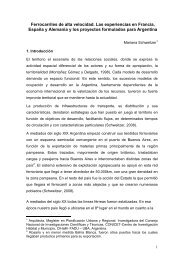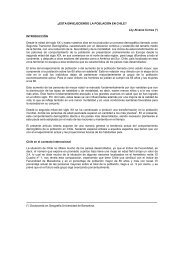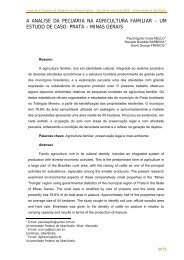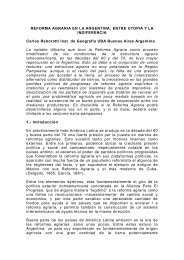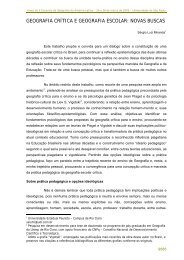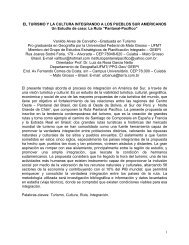Aplicación de un sistema de información geoestadística para la ...
Aplicación de un sistema de información geoestadística para la ...
Aplicación de un sistema de información geoestadística para la ...
You also want an ePaper? Increase the reach of your titles
YUMPU automatically turns print PDFs into web optimized ePapers that Google loves.
<strong>Aplicación</strong> <strong>de</strong> <strong>un</strong> <strong>sistema</strong> <strong>de</strong> <strong>información</strong> <strong>geoestadística</strong> <strong>para</strong> <strong>la</strong> evaluación <strong>de</strong> los<br />
agentes corrosivos ambientales en <strong>la</strong> <strong>de</strong>gradación <strong>de</strong> <strong>la</strong> infraestructura <strong>de</strong> puentes en<br />
México.<br />
RESUMEN<br />
Este trabajo presenta los avances en el conocimiento sobre el grado <strong>de</strong> <strong>de</strong>terioro por<br />
corrosión que guarda <strong>la</strong> infraestructura <strong>de</strong> puentes <strong>de</strong> <strong>la</strong> red fe<strong>de</strong>ral <strong>de</strong> carreteras en México,<br />
en f<strong>un</strong>ción <strong>de</strong> su posición geográfica y factores climáticos relevantes <strong>de</strong> <strong>la</strong> zona en que están<br />
ubicados. El principal objetivo <strong>de</strong> esta investigación consiste en generar <strong>un</strong> programa<br />
continuo <strong>de</strong> monitoreo y evaluación por corrosión <strong>de</strong> <strong>la</strong> infraestructura <strong>de</strong> puentes en México<br />
y en <strong>de</strong>terminar <strong>la</strong>s posibles soluciones <strong>para</strong> disminuir el proceso <strong>de</strong> <strong>de</strong>gradación que por<br />
corrosión es <strong>la</strong>tente en los puentes mexicanos. Se incluyen los resultados <strong>de</strong>l inventario<br />
nacional <strong>de</strong> puentes generado en esta investigación con <strong>la</strong> asistencia <strong>de</strong> <strong>la</strong> Secretaria <strong>de</strong><br />
Com<strong>un</strong>icaciones y Transportes, Dirección General <strong>de</strong> Servicios Técnicos. Finalmente se<br />
presentan los resultados obtenidos <strong>de</strong> inspecciones visuales realizadas en el campo, los<br />
cuales fueron com<strong>para</strong>dos con los resultados <strong>de</strong>l análisis espacial, utilizando herramientas<br />
<strong>de</strong> <strong>sistema</strong>s <strong>de</strong> <strong>información</strong> geográfica.<br />
Pa<strong>la</strong>bras c<strong>la</strong>ve: análisis espacial, corrosión, <strong>de</strong>gradación, estructuras <strong>de</strong> concreto, puentes,<br />
Sistemas <strong>de</strong> Información Geográfica.<br />
ABSTRACT<br />
This work presents an initial effort to <strong>de</strong>termine the <strong>de</strong>gree of corrosion that the fe<strong>de</strong>ral road<br />
bridge infrastructure in Mexico manifests as a f<strong>un</strong>ction of relevant environmental factors. The<br />
main objective of this investigation is to create a continuous corrosion monitoring and<br />
evaluation program for the bridge infrastructure in Mexico and to <strong>de</strong>termine the possible<br />
solutions to <strong>de</strong>crease the <strong>de</strong>gradation process of bridge corrosion in Mexico. It also inclu<strong>de</strong>s<br />
the results obtained from a national bridge inventory generated with the Mexican Ministry of<br />
Transport and Comm<strong>un</strong>ications, General Technical Directorate, assistance. The results of<br />
several field inspections performed to some bridges that show this <strong>de</strong>gradation process was<br />
obtained and compared with the results of spatial analysis using GIS technology.<br />
Key words: spatial analysis, corrosion, <strong>de</strong>gradation, concrete structures, bridges, geographic<br />
information systems.<br />
Introducción.<br />
Los metales en general, salvo los metales nobles, se encuentran en estado natural<br />
combinados con otros elementos químicos formando minerales como: óxidos, carbonatos<br />
sulfuros, etc. Para obtener los metales en estado puro, se recurre a <strong>la</strong> extracción a partir <strong>de</strong><br />
sus minerales, lo que en muchos casos requiere <strong>de</strong> <strong>un</strong> gran aporte energético.


